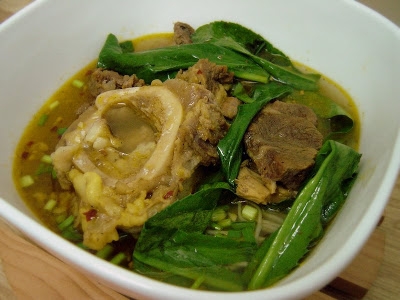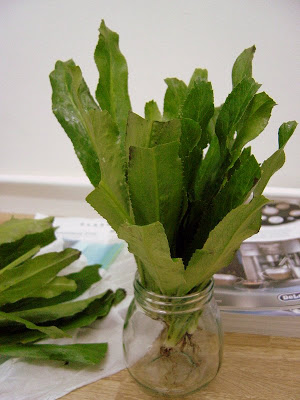
Last Saturday I spent a wonderful lunch with an awesome bunch of food bloggers and friends in a ranch outside the city. The weather was absolutely perfect and the grounds were stunning. We had a five course meal prepared by a private chef in a fantastic setting. Best among all the elements though, was the fantastic camaraderie and great fun that we shared. From the time we set off in our little convoy of cars, until the time we drove back, sleepy and sated, the air was filled with laughter and good vibes. My fellow bloggers who were present have already written it up and you can read about our adventure here:
Gypsysoul
Tennis & Conversation
Our Awesome Planet
Rants & Raves
Another highlight of that afternoon was the owner’s herb garden, whose produce is used by the chef in the meals he prepares there (like ours!). Rows of sprightly, bright green aromatics were quite a sight for a tired city girl’s eyes. And the smells! I needed only to run my fingers lightly on them and my whole hand smelled of rosemary or coriander. I bought a bunch of rosemary and oregano, but what keep pulling me towards it (whether by its scent or its looks, I do not know) was the Vietnamese coriander. It smelled like an almost violent cilantro…strong and assertive. It was the first time I had come across it and I was intrigued, so I took a bunch of that as well.

Back home I was a flurry of hunting down recipes for my new herb. This type of herb is used mostly in soups…and Vietnamese soups are something that I have never tried at home. Actually, I have never tried making Vietnamese anything! Luckily, I found a recipe for just such a soup (Bún Bò Huế) in my October 2006 issue of Saveur. I heavily adapted it though to suit what I had on hand (just half a kilo of beef shank and some bone with marrow), as well as the time I had to work with (not enough time to boil meats, then refrigerate, then slice, and all the rest). I ended up with something I like to think of as Vietnamese Nilaga, or, as below, Vietnamese Style Bulalo (bone marrow).
Vietnamese Style Bulalo (bone marrow)
(adapted from Bún Bò Huế recipe in Saveur October 2006 issue)
- 2 tablespoons + 4 tablespoons canola oil
- 3 medium yellow onions (2 chopped and 1 sliced thinly)
- ½ tablespoon annatto seeds (atsuete)
- 500 grams boneless beef shank, cut into roughly 1 inch chunks
- 2-3 1.5-inch pieces of bone with marrow (bulalo)
- Salt and freshly ground black pepper
- 2 tablespoons + 2 ½ teaspoons fish sauce (patis)
- 5 trimmed stalks of lemongrass (4 cut into 3-inch pieces and bruised, 1 minced)
- 1 teaspoon + 1 teaspoon sugar
- 2 teaspoons dried chili flakes
- 4 cloves garlic minced
- 1 teaspoon shrimp paste (bagoong)
- 150 grams Vietnamese egg noodles, boiled as per packaged directions
- A large bunch of Vietnamese coriander or culantro, root end removed
- 4 scallions, chopped
– Heat 2 tablespoons oil in a stockpot then add chopped onions. Cook onions until slightly soft, around 2 minutes. Add annatto seeds and cook until onions are dark yellow, around 4-5 minutes.
– Season beef with salt and pepper and add to the pot, pushing the onions to one side. Sear for about 4-5 minutes. Add 2 ½ liters of water and bring to a boil. Skim off and discard scum that forms on top. Add 2 tablespoons of fish sauce, bruised lemongrass, and 1 teaspoon sugar. Lower heat and simmer until meat is tender.
– While your meat is simmering, get on with the chili mix. Place remaining oil, chili flakes, garlic, and minced lemongrass in a small pot and gently simmer until fragrant (about 5 minutes). Remove from heat and stir in remaining fish sauce and sugar. Set aside.
– When meat is tender add shrimp paste and chili mixture (to taste). Taste for seasoning and adjust if needed. At the last moment toss in Vietnamese coriander and take off heat.
– Divide noodles into bowls (this will serve 2-3 people). Top each bowl with sliced onions and scallions. Pour the hot broth with some beef and bulalo into each bowl. Serve with remaining chili mix.The hot, fortifying, meal-in-a-bowl came out better then I expected. This is one of those “hits-the-spot” soups. The broth was beefy and flavorful, the beef fork-tender, and the smells emanating from the kitchen were new and exotic…the smell of Vietnamese cooking! The marrow/bulalo was its usual unctuous and mind-melting self (I’m a BIG marrow fan, obviously), with a new dimension as it melded deliciously with the distinct flavors of the broth. C and I hunkered over our bowls; the only sound our contented slurping.Looking at other resources, the herb I had looked different from the pictures of Vietnamese coriander on the internet. It actually appeared more like culantro, another cilantro/coriander relation, more aromatic than both Vietnamese coriander (which is actually milder) and cilantro. Upon further investigation, it seemed that the herb I had on hand was indeed culantro (I have amended the recipe above to include both). The March 2006 issue of Saveur featured it. Culantro is indigenous to the West Indies but is used all over, including Vietnam, where it is called ngo gai (as opposed to Vietnamese coriander which is referred to as rau rǎm) and is one of the standard herbs in pho and other soups. Whew! So I was not totally off-base when I used it! And more good news: As I have discovered it to be culantro, I now have a new bunch of recipes in which to use it…all hailing from Trinidad! Who knew you could go all around the world and never leave you kitchen?UPDATE 2/13 — C made a very typical local salad of chopped tomatoes, onions, and shrimp paste (bagoong) to go with some fried fish last week. We chopped up some of the culantro and tossed it in the salad. Simple but amazingly flavorful and delicious!
Hello Chichajo.
I'm a new reader of your blog and I love your entries. I've seen this herb in Trinidad before. They call it culantro or Chadon Benit (pronounced as shadow benny) and yes it's like cilantro x10. They use this in virutally all their dishes from curries to souse and it grows practically on the roadside. Super pungent… If you want this the seedling bank near Q ave carries some sprouts/seedlings of this plant.
Kind regards,
Jelo
Hi Jelo! Glad you enjoyed the blog and thanks for leaving a nice comment 🙂 Love culantro! I also find it sometimes with the organic veggie farmer I like to buy from in the Salcedo market…you've got me thinking of making this again soon!
From Trinidad, another recipe.
We call your culantro chadon beni or bandhania.
Mango Chow:
Peel and slice a half-ripe mango. Add:
half teaspoon salt
freshly chopped pepper (as much as you like)
chopped garlic (ditto)
AND one or two chopped chadon beni/culantro/bandhania leaves.
Mix. Chill for half an hour.
ENJOY!